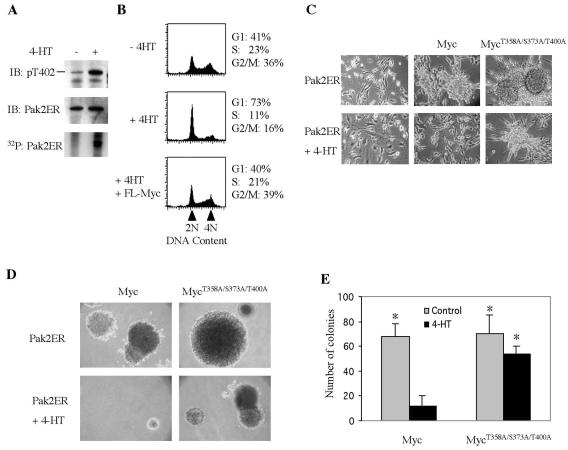FIG. 8.
Phosphorylation by Pak2 reduces cellular transformation by Myc. Retroviral vectors were used to express the Pak2ER construct and various alleles of Myc in NIH 3T3 cells. The enzymatic activity of the Pak2ER protein was elicited by exposure of the cells to 4-HT, as described in Materials and Methods. (A) Induction of enzymatic activity by 4-HT. Cells were incubated with 4-HT for 2 h, then labeled with [32P]orthophosphate for 12 h, and harvested for analysis by immunoprecipitation of the Pak2ER protein. The precipitates were analyzed by immunoblotting (IB) for phosphorylation of T402 in Pak2 and for the total mass of Pak2ER protein. Labeling of the protein by 32P was detected by autoradiography. (B) Induction of Pak2 activity arrests cells in G1. Cells were exposed to 4-HT for 2 days and then analyzed by fluorescence-activated cell sorting after labeling with propidium iodide, gating on Myc-positive cells with GFP as the indicative parameter. (C) Induction of Pak2 activity reduces morphological transformation by Myc. Cells were exposed to 4-HT for 6 days and then subjected to photomicroscopy at a magnification of ×200. (D) Induction of Pak2 reduces anchorage-independent growth elicited by Myc. Colonies in soft agar were photographed at a magnification of ×40 after 21 days in either the absence or presence of 4-HT. (E) Quantification of anchorage-independent growth. Colonies were counted in 10 random fields. The histograms represent the mean from three experiments, with error bars indicating standard deviation (*, P < 0.02).

